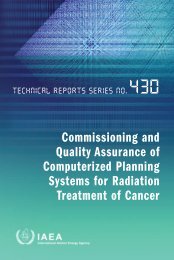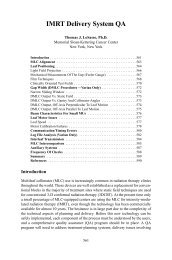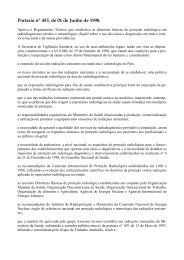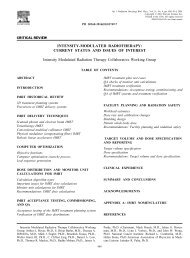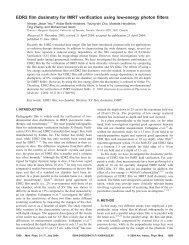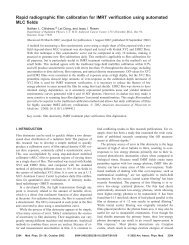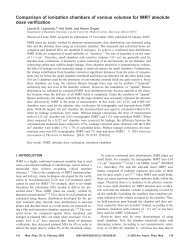Clinical evaluation of monitor unit software and the application of ...
Clinical evaluation of monitor unit software and the application of ...
Clinical evaluation of monitor unit software and the application of ...
You also want an ePaper? Increase the reach of your titles
YUMPU automatically turns print PDFs into web optimized ePapers that Google loves.
a<br />
b<br />
Frequency<br />
Frequency<br />
120<br />
100<br />
80<br />
60<br />
40<br />
20<br />
70<br />
60<br />
50<br />
40<br />
30<br />
20<br />
10<br />
0<br />
0<br />
-11%<br />
-10%<br />
-11%<br />
-10%<br />
-9%<br />
-8%<br />
-7%<br />
-6%<br />
-5%<br />
-4%<br />
-3%<br />
-2%<br />
tient safety regulations because all treatment plans would<br />
be subjected to automated independent dose calculations.<br />
Ideally, such an automated procedure is followed by a retrospective<br />
analysis that continuously scans through <strong>the</strong><br />
database looking for systematic sources <strong>of</strong> dose calculation<br />
error/uncertainties. This may consequently be an additional<br />
QA strategy where small but systematic error/uncertainties,<br />
ei<strong>the</strong>r in <strong>the</strong> planning calculation or in <strong>the</strong> independent dose<br />
calculation, can be found <strong>and</strong> possibly also explained <strong>and</strong><br />
fixed. However, for such an automated QA-procedure it is<br />
still necessary to check <strong>the</strong> treatment plan by an experi-<br />
D. Georg et al. / Radio<strong>the</strong>rapy <strong>and</strong> Oncology 85 (2007) 306–315 313<br />
All data<br />
Deviation (MUV-TPS)/MUV [%]<br />
Only radiological depth data<br />
-9%<br />
-8%<br />
-7%<br />
-6%<br />
-5%<br />
-4%<br />
-3%<br />
-2%<br />
-1%<br />
0%<br />
1%<br />
2%<br />
3%<br />
Deviation (MUV-TPS)/MUV [%]<br />
thorax<br />
HN<br />
pelvic<br />
-1%<br />
0%<br />
1%<br />
2%<br />
3%<br />
4%<br />
5%<br />
6%<br />
7%<br />
8%<br />
9%<br />
RD thorax<br />
RD HN<br />
RD pelvis<br />
enced pr<strong>of</strong>essional in order to avoid hot spots, dose prescription<br />
<strong>and</strong> plan normalisation errors. Independent dose<br />
calculations based on export files from TPS do not check<br />
correct data file transfer from <strong>the</strong> TPS to <strong>the</strong> treatment <strong>unit</strong><br />
<strong>and</strong> <strong>the</strong> actual performance <strong>of</strong> <strong>the</strong> treatment <strong>unit</strong>, which<br />
are o<strong>the</strong>r sources <strong>of</strong> error in <strong>the</strong> radio<strong>the</strong>rapy chain. However,<br />
<strong>the</strong>se aspects could be included by measuring leaf settings<br />
<strong>and</strong> MU measured with an EPID [23]. Moreover, such<br />
information could be used as well as input information for<br />
an independent dose calculation. Finally, <strong>the</strong>re is also a tangible<br />
risk for errors to be introduced by <strong>the</strong> user(s) during<br />
10%<br />
4%<br />
5%<br />
6%<br />
7%<br />
8%<br />
9%<br />
10%<br />
Fig. 3. Treatment site dependent frequency distributions <strong>of</strong> deviations between dose calculations performed with MUV <strong>and</strong> <strong>the</strong> local TPS. (a)<br />
Using input data based on ei<strong>the</strong>r geometric or radiological depth, (b) using input data based on radiological depth only.



